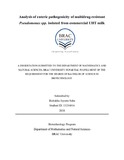Analysis of enteric pathogenicity of multidrug-resistant Pseudomonas spp. isolated from commercial UHT milk
Abstract
Pseudomonas is a kind of bacteria that has the ability to develop resistance to antibiotics rather rapidly over several generations. This resistance present in some strains makes Pseudomonas a very difficult to treat once a host, such as a human or other animal, is infected. The purpose of this study was to analyze the antibiotic resistant genes of Pseudomonas spp. through molecular techniques along with the assessment of enteric pathogenesis using animal modeling. Primarily, the isolates were characterized morphologically and identified by 16S rRNA as Pseudomonas spp. Presence of antibiotic resistant genes were tested for 8 screened isolates from antibiogram from 25 environmental (Soil), Clinical and UHT milk isolates using specific oligonucleotide primers (VIM 2-F & VIM 2-R, IMP 1-F & IMP 1-R, OXA 2-F & OXA 2-R) in gradient PCR. Enteric pathogenetic nature of the isolates was tested using two standard animal models. Out of 25 isolates, 8 isolates showed high multidrug resistance and the presence of antibiotic resistant genes were confirmed by amplifying 865bp, 587bp and 810bp DNA fragments respectively in PCR. Total cellular partially purified protein extracted from 8 pathogenic multidrug resistant isolates selected from PCR, tested for SDS PAGE to produce patterns with wide range of discrete bands with specific molecular weight. Presences of antibiotic resistant genes were confirmed by PCR and no protein was detected by SDS-PAGE according to specific molecular weight. Enteric pathogenesis was observed from the rabbit ileal loop fluid accumulation and physiological changes followed by direct consumption in rats. Detection of pathogenic multidrug resistant microbial strains can lead us to a solution for outbreak of enteric infection.

